 |
 |
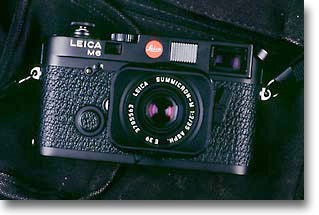 |
Sooner or later virtually every photographer will be tempted to buy what has been called the quintessential marque of cameras:
a legendary system that continues its great heritage and one with a very unique and devoted group of users. I'm talking of course about the Leica. I'm not a long time Leica user as I've really only been using them since about 1997. |
|
I initially bought into the system because I was looking for something small and quiet to compliment my other equipment. I often take photos during events or in places where I do not want a disturbing clack or the sound of a motor every time I take a shot. I also found that I was slowly moving away from my subjects and often relying on a 200mm lens to get images. I wanted to get close to my subjects again and the M-6 seemed to be the perfect choice. |
 |
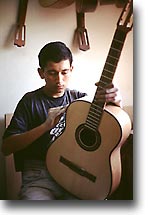 |
Leica has been the camera of choice for great photographers like Eugene Smith, Henri Cartier-Bresson, Ralph Gibson, Robert Capa, Alfred Eisenstadt and Sebastiao Salgado. The inside back page of National Geographic Magazine often features photographers sporting a M-series camera and many photojournalists have one packed away somewhere. I think one reason the M-series Leicas have maintained popularity among photographers is their desire to emulate the work of those they admire. A logical first step is to duplicate the equipment used by those masters. Unfortunately, that can be a pitfall as each of us have our own vision and style and the Leica rangefinder may not actually fit that vision. Leica M-series cameras have built up such an incredible reputation over the years that it seems as if they are near perfection. There are many things about the Leica M-series rangefinder cameras that I love. But I've had a few frustrations too as I've learned to use this unique tool. |
|
The M-6 is very well made and it certainly has a feel to it that is quite intoxicating. If you don't want to buy one, don't pick one up and you probably should not be reading this.
Having shot with SLRs for some 15 years, I've had a difficult time adjusting to it. With a SLR you can compose and focus at the same time. With a rangefinder you have to line up the double image in the center. I almost never have the point of interest in the exact center so I have to recompose after focusing. That also means it is near impossible to follow-focus while maintaining composition. |
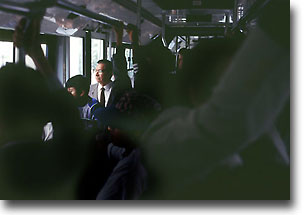 |
 |
Under certain circumstances, in theory at least, the rangefinder provides more accurate focusing than the SLR. That is true in a practical sense only if the subject distance doesn't change. Candid shots of moving kids are not the M's forte unless you are using a wide angle lens and a f/stop that affords lots of depth-of-field.
M-series cameras are often touted as being superb available light cameras. With good reason I might add as Leica has the 35mm f/1.4 Summilux ASPH, 50mm f/1 Noctilux and 75mm f/1.4 Summilux. |
|
Since the rangefinder camera has no mirror to move or diaphram to close, most people find they can hold the body using slower shutter speeds. The general consensus is that you can hold a M-series camera two stop slower than with your SLR.
Before you get all excited, remember that many subjects move enough that they tend to blur at either 1/60 or 1/30. I've been using Tom Abrahamssons' soft releases which help considerably at slow speeds. The accompanying hand-held shot (leaning on a pew) was taken with the 35 Summicron ASPH at 1/4 sec at f/2 using Provia 100. The slide is really sharp, but a tripod would have been helpful. |
 |
 |
The disadvantage of the rangefinder is that it has no focusing screen so you can't visualize how shallow the zone of focus really is. Everything looks sharp through the rangefinder window whether it is in focus or not.
In this situation the SLR wins big time.
However, if you are taking photographs where virtually everything will be in focus, the M-series viewfinder is perfect and sure beats using a SLR's depth-of-field preview. If you like using dark colored filters, you'll prefer the M-series camera. If you like using graduated neutral density ones, you really need to look through the lens to accurately position them. So I'd suggest you keep a SLR.
One of the greatest advantages of the SLR viewfinder is that you eliminate all extraneous details from view. With the rangefinder you see things outside of the framelines that can be rather distracting. On the other hand, since there is no mirror "blackout" with the rangefinder, the subject is always visible and you can see whether someone blinks or if something is about to enter the frame. |
|
The viewfinder is not all that friendly to eye-glass wearers like myself either. I find it impossible to see the 28mm framelines and the 35 framelines aren't exactly a joy to use.
I find that I tend to have more wasted space around the image with the M-6 and I'm still a bit distracted by the area outside of the framelines. After being rather perplexed by the amount of wasted space in the images shot with my M-6, I discovered that the framelines are only designed to be accurate at the minimum focusing distance. As you change focus, the image extends outside of the frame lines. This is more than a slight annoyance as I've found the difference to be roughly equal to adding three or four thicknesses of the frames on all sides.
|
 |
 |
One of the initial struggles I had with M-series lenses was the minimum focusing distance. Using SLRs really spoils you in that normal lenses focus to 14" or 18" and a macro lens will focus down to several inches. With a M-series lens, the close-focus distance is either about 27" or 39", depending on the lens. Once again this is often not a big problem unless you like taking close-ups of small objects and children's faces or work in really small radio studios. It is quite annoying to have to back up several inches to focus a shot. |
|
There are ways of taking close-ups using M-series cameras.
The most notable way is by using the Visoflex system.
The Visoflex essentially turns your rangefinder camera into a SLR
by adding a mirror box, focusing screen and a viewfinder to the camera.
Leica made a whole series of adapters that allowed you to use bellows
units and certain lenses for the system.
Some earlier M-series lenses were made in a way that you could
literally unscrew the head or front section of the lens to put it in
front of the Visoflex unit. Leica also made several longer telephoto
lenses specifically for use with the Visoflex. Realize that the 65mm
is the widest lens for the system but in practice this is not a problem.
A far easier way for moderate close-ups is to buy a 50mm Dual Range Summicron. This lens has two focusing ranges. Normal focus is from from 39" to infinity. By adding a special viewfinder or "eyes" to the lens you can switch to the near focus range from 18" to 39". To be honest, Leica discontinued both of these systems a long time ago as a SLR and a macro lens is a whole lot easier to use and much less cumbersome. |
|
Lens selection for the M-series system is far more limited than your typical SLR line.
The widest new lens available is the 21mm and the longest is a 135mm.
Quite frankly, the 135mm frame is so small in all of the M-series cameras (with the
possible exception of the M-3 and M-6HM) that it is hardly fun to use.
The M-series wide angles need an accessory viewfinder for the hot shoe. This arrangement isn't exactly convenient since you still focus through the camera's viewfinder, but view the scene through the accessory finder. The other disadvantage of this arrangement is that the finder occupies the hot shoe so you have to figure out some other way to mount your flash or studio flash trigger. |
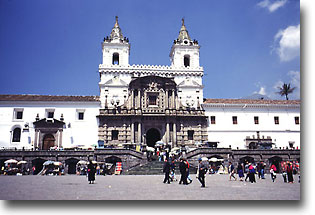 |
 |
Realize that most people don't use a flash with M cameras or with a 21mm or 24mm lens, so in practice this is not a big problem.
The M-6 metering system is a bit different from many SLR's as well. First off there is no visible way to view the metered area through the viewfinder. It is equivilant to a circle roughly two-thirds of the viewfinder frame's height. The meter consists of two arrows that glow equally when you've reached the right exposure. The metering system has probably been the hardest part of the M-6 for me to adjust to. I'm used to my SLR's spot metering pattern that is much smaller than the M-6's coverage. My SLR's meter also allows you to see the range of reflectance or light levels within a scene for a number of stops above and below the "exposure" without changing the aperature or shutter speed. So I've been carrying an incident lightmeter to help confirm exposures. |
|
At this point you may be wondering whether a system that has many limitations is really worth the considerable price.
The important thing as a photographer is to know the strengths and weakness of all your equipment and then choose the appropriate one for any given situation.
Is it worth the money? That's a hard question to answer.
There is a parable in Matthew, Chapter 13, where Jesus is talking about how great the kingdom of heaven is. He tells us that it is like the merchant who was looking for fine pearls and when he found one of great value, he sold everything he had to buy it. We could loosely paraphrase that to say that the kingdom of heaven is like a photographer who was looking for a fine camera and when he saw a Leica, he sold everything he had to buy it. The point is that you need to choose what is important in your life. Whether it is your relationship with God in the spiritual sense or using Leica cameras in the photographical sense. |
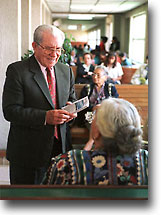 |
 |
Over the last couple of years, I have come to appreciate a number of things about the Leica M-series system. It's a great camera for getting in close to your subject and it doesn't attract attention or intimidate subjects like an EOS 1n with motor and 28-70 2.8L zoom.
It's small, it's quiet, and it certainly seems like you can get pictures of subjects and expressions with it that you would not be able to capture otherwise.
The lens quality is absolutely astounding and it seems to capture fine details that get lost with other lenses. Images taken with it seem to have a greater appearence of sharpness and B&W images have amazing tonality. I was astonished by the difference the first time I enlarged negatives shot with my M-6. |
|
The viewfinder is perfect for scenes where there is a broad zone of sharpness, particularily when using a wide angle lens.
With a few days of practice you can learn to focus by distance and ignore the the double image rangefinder all together for most scenes.
There is no mirror "black-out" during exposure so you are in visual contact with your subject at all times.
The physical construction and mechanical feel is quite unique among current cameras and it's a camera that will keep on working for decades. Is a M-6 or M-series camera right for everyone? Is it the perfect system? No system is perfect for everyone. It's really a matter of choosing what's best for you and your photography. It could be the ideal system for some people doing only certain limited types of photography. But there are times and subjects when you really need motors, zoom lenses, auto focus, macro lenses and long telephotos. |
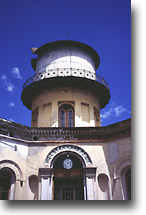 |
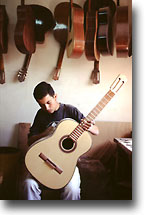 |
If you can afford it, I think a Leica M-series rangefinder makes an ideal companion system to a SLR kit. It can also serve as the primary system for some photographers with perhaps a SLR and a couple lenses for certain subjects. It does take some getting used to though especially if you are a long time SLR user. I'd recommend that you try one for a few days before buying a complete system.
The Leica M-series rangefinder is a camera that seems almost timeless. It has a simple but elegant design and it eliminates all of the unneccesary stuff found on nearly any modern camera. The Leica M-series camera system certainly has a well deserved and long-standing reputation of being the finest equipment available. Many top photographers still rely upon it to produce some of the worlds greatest images. That factor alone makes it a system worth trying. |